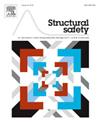基于梯度增强物理信息神经网络和概率密度演化方法的结构可靠性分析
IF 6.3
1区 工程技术
Q1 ENGINEERING, CIVIL
引用次数: 0
摘要
近十年来,概率密度演化法(PDEM)已成为进行结构整体可靠度分析(SRA)的最常用方法之一。基于pdem的SRA的主要过程是求解与虚拟随机过程相关的广义概率密度演化方程(GDEE)。常用的GDEE求解方法对求解参数的选择高度敏感,可能影响求解的精度、效率和稳定性。近年来,物理信息神经网络(PINN)及其扩展形式已成功地用于求解不同领域的微分方程。鉴于此,利用梯度增强的PINN (gPINN)来求解SRA的VSP的GDEE,从而得到一种改进的进化概率密度(EPD)-gPINN模型。具体来说,将归一化GDEE方程和附加梯度残差方程导出为物理损失。同时,为了提供足够的有监督的训练数据,建立了易于操作的数据增强程序。通过数值算例验证了所提框架的有效性。通过参数分析研究了网络参数对预测性能的影响。结果表明,采用适当的梯度损失权重,该框架可以有效地进行SRA,其预测性能优于PINN。本文章由计算机程序翻译,如有差异,请以英文原文为准。
Structural reliability analysis using gradient-enhanced physics-informed neural network and probability density evolution method
In past decade, probability density evolution method (PDEM) has become one of the most popular approaches to conduct overall structural reliability analysis (SRA). The main procedure of the PDEM-based SRA lies in solving the generalized probability density evolution equation (GDEE) related to virtual stochastic process (VSP). Common methods for GDEE solving are highly sensitive to the choice of solving parameters, which may affect the accuracy, efficiency and stability of the solution. Recently, physics-informed neural network (PINN) and its extended form have successfully utilized to solve differential equations in different fields. With this in view, the gradient-enhanced PINN (gPINN) are utilized to solve the GDEE of the VSP for SRA, which leads to an improved approach, termed as evolutionary probability density (EPD)-gPINN model. Specifically, the normalized GDEE and the additional gradient residual equations are derived as the physical loss. Meanwhile, to offer sufficient supervised training data, an easy-to-operate data augmentation procedure is established. Numerical examples are posed for validating the validity of the proposed framework. Parametric analysis is conducted to investigate the influence of the network parameters to the predictive performance. Results indicate that using proper weight of the gradient loss, the proposed framework can efficiently conduct the SRA, whose predictive performance outperforms PINN.
求助全文
通过发布文献求助,成功后即可免费获取论文全文。
去求助
来源期刊

Structural Safety
工程技术-工程:土木
CiteScore
11.30
自引率
8.60%
发文量
67
审稿时长
53 days
期刊介绍:
Structural Safety is an international journal devoted to integrated risk assessment for a wide range of constructed facilities such as buildings, bridges, earth structures, offshore facilities, dams, lifelines and nuclear structural systems. Its purpose is to foster communication about risk and reliability among technical disciplines involved in design and construction, and to enhance the use of risk management in the constructed environment
 求助内容:
求助内容: 应助结果提醒方式:
应助结果提醒方式:


